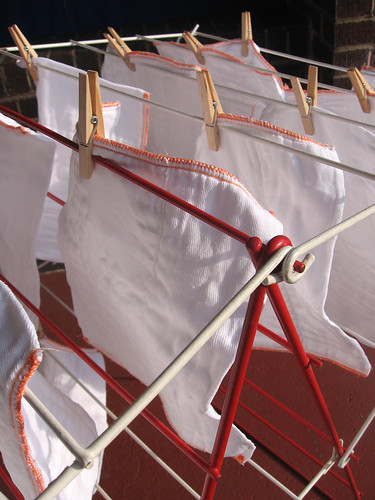 Donkey's years ago, Missy of a work in progress… asked me if I had any tips for laundering cloth diapers if you don't have your own washer and dryer. I just hope I get this post up before she has her second baby…
Donkey's years ago, Missy of a work in progress… asked me if I had any tips for laundering cloth diapers if you don't have your own washer and dryer. I just hope I get this post up before she has her second baby…I have actually given this quite a lot of thought, because we were pregnant with Mikko in one apartment and spent his first two years in another, and neither had a washer and dryer or hookups to get them. We knew we wanted to cloth diaper, so I started research if such a thing would be possible for us, and it turns out: It is!
You have a few options: You can use your building's communal laundry facilities (such as at an apartment complex), you can go to a laundromat, or you can rig up your own non-standard washing facilities at home. I'll start with the first two options since they're the most common.
Just a note: I'm going to use the term "apartment," because that's the most likely scenario for someone considering this. However, this information can just as well apply to people in rental houses or condos, dormitories, houseboats, RVs, and the like.
How to launder cloth diapers in a communal washing machine
I am compiling these tips from various sources, to wit:
- Diaper Pin
- Cotton Babies
- Green Mountain Diapers
- Bunting Resources on Associated Content
- Diaper Junction
- StorkNet's Cloth Diaper Cubby
- The Diaper Jungle
Here's my best guess of how to put it all together. Remember that cloth diaper laundry is almost an art form, so feel free to experiment. The hardness of your water, the type of detergent and how much you use, whether your baby's eating solids yet, how old your diapers are, the efficiency of the machines you have available — they're all variables, so feel free to play around and find out what works for you.
- Run a wash on COLD (with cold-water rinse) with just a touch of detergent or none at all. This is more like a presoak to loosen the poop. (It might be possible to prop open the lid and allow for a soak with just a single wash cycle, but check that this won't just eat your money or anger the laundromat staff.)
- Add 1/4 the amount of detergent recommended for the load size and 1/2 cup baking soda (for

odor neutralization, if desired) and run a HOT wash cycle (with cold-water rinse). If you want to save energy, you can experiment with a warm wash instead and see if the diapers seem clean. Hot will be more disinfecting. You don't want to add too much detergent, since it will likely not be possible to do an extra rinse.
- Add 1/2 cup vinegar to the rinse cycle. If the machine you're using has a compartment to load fabric softener into for the rinse cycle, pour in the vinegar there. If not, you have these options: Stand around waiting for the rinse cycle, or use a timer to alert you to check for the rinse cycle (as with a basement laundry room), and then open up the machine and pour in the vinegar by hand (yes, I've done this many a time!).
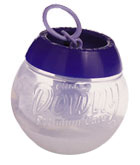
Or, get one of those Downy fabric softener balls
and add the vinegar to that. Cap it, and toss it in during the hot wash. (That's by far the easiest option!) The vinegar will act as a diaper-safe fabric softener and rinse aid. If you're getting a strong ammonia smell after the diapers are washed, however, your water might be too hard for vinegar. In that case, skip it and go for dryer balls
for softening instead.
- If by any chance the machine allows for an extra rinse, go for it, on cold. This is likely not an option.
- Otherwise, check the diapers and see if they seem clean. Do they smell neutral? Do they look bright? Has all the detergent washed out, or do they seem crunchy? If all is well, on to drying. If not, run another warm or cold wash (depending on degree of retained yuckiness), with no added detergent. Hopefully this will not be necessary, or only very rarely.
- Now sort out any diapers or diaper covers that cannot be put in the dryer, and pop the rest into the biggest dryer you can find. Allow room for them to tumble freely, and dry on high heat for the maximum time. Don't use any fabric softener sheets, as these can diminish absorbency.
You can try dryer balls
if you want added softness. To save money, energy, and wear and tear on your diapers, you can skip the dryer and bring your diapers into your home to air dry. Invest in one or more folding drying racks
— at least one for any covers and other diapers that can't be machine dried (some all-in-ones, anything wool, etc.) — and several if you're going to be line drying the lot. You can also stretch a retractable clothesline
across your shower or kitchen. You might be able to dry some out on your balcony or patio, but check the building's regulations to be sure.
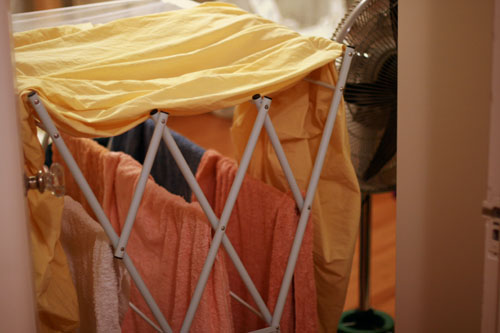
We found drying laundry indoors took a lot less time
if you aimed an electric fan at the rack!
GENERAL TIPS AND INFO ON WASHING IN A COMMUNAL WASHER/DRYER:
Your stash:
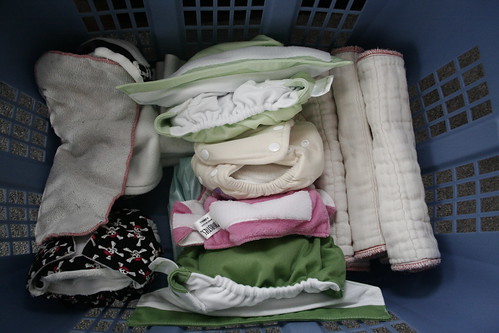
- Have lots of diapers, as you can afford, so you don't have to do laundry as often. If you can build up a stash that lets you go only once or twice a week, life will be less frantic.
- As far as what kind of diaper to get, here's a helpful rundown of the various cloth-diaper types at The Making of a Modern Mommy. I know everyone has preferences, and the urge to build a fabulous and varied stash can be strong, but might I put in a plug for the humble prefold with simple cover? Particularly in this situation of laundering less often, with fewer wash options, and in larger loads, it can help to have a completely uniform load of diapers to wash. You could easily wash the covers by hand (we always did), and then all the rest of the diapers can be washed and dried in the same way. If you're trying to save on money, prefolds, too, can be a cost-effective option, and will be easier to buy in bulk so you don't have to do laundry as often.
Line drying:
- Hanging diapers to dry is recommended, and essential for many covers and all-in-ones, so don't feel you're missing out there if you want to skip the expense of the dryer. Having a nice drying rack — or, ideally, more than one — will help you keep the diaper drying contained and manageable. We had one that was foldable and one that hung from the wall, and we still ended up drying things hanging over doors and doorknobs and shower rods!
- If you want to bleach your diapers in the sun, you might have fewer options. If you have a balcony or sunny window, you can give that a try. I know in our building, though, there are rules about not hanging up laundry on our balconies, so check if you're not sure. If needed, you can try a little oxygen (not chlorine) bleach
.
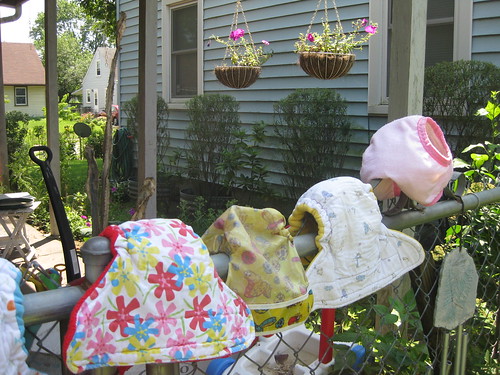
The cost:
- As far as the math goes, Born to Love suggests the cost for washing cloth diapers in a coin-operated machine would be approximately $22.20 a month for two loads a week. I'll try to tease this out further, however. For one thing, this doesn't include the cost of detergent, other additives, or the diapers themselves. But, more importantly, it doesn't seem to allow for the extra wash cycle, unless it's assuming you're not using the dryer. In Seattle apartments, a load usually costs $1.25, and in laundromats, $1.50 for the standard washers (last time I looked) and more for the larger-capacity ones, but there you're saving if you fill the machine. Let's use $1.40 as a happy medium, and assume the price will be higher in some areas and lower in others. Let's also assume you do diaper laundry twice a week, one load of diapers at a time, with two wash cycles and one drying. That would be $8.40 a week. Green Baby Guide pegs the cost of Biokleen detergent
at $1.39 a load and
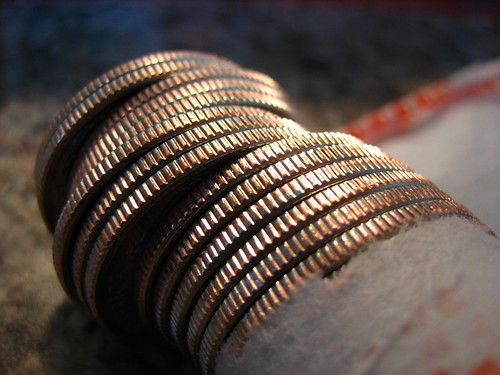 also notes start-up costs for buying diapers at $120-$600. Let's assume you add cheap-o vinegar at $0.10 a load (I have no idea and don't feel like figuring it out; it's nearly negligible, yes?). All right, now we have $11.38 a week. If we take the middle of the road for startup costs, $360, and assume you use the diapers you buy for 2 years (which doesn't include the potential thriftiness of using them for future children or reselling them), that's $3.46 a week in diaper costs. So, all told, $14.84 to cloth diaper a baby in an apartment for a week. Give or take several math errors and wrong assumptions. Our diaper service charged $17.70 a week for 70 diapers, their recommended amount for a newborn, so it looks like you're still coming out ahead by doing the laundry yourself, if money's a factor. (And it's always a factor, isn't it?)
also notes start-up costs for buying diapers at $120-$600. Let's assume you add cheap-o vinegar at $0.10 a load (I have no idea and don't feel like figuring it out; it's nearly negligible, yes?). All right, now we have $11.38 a week. If we take the middle of the road for startup costs, $360, and assume you use the diapers you buy for 2 years (which doesn't include the potential thriftiness of using them for future children or reselling them), that's $3.46 a week in diaper costs. So, all told, $14.84 to cloth diaper a baby in an apartment for a week. Give or take several math errors and wrong assumptions. Our diaper service charged $17.70 a week for 70 diapers, their recommended amount for a newborn, so it looks like you're still coming out ahead by doing the laundry yourself, if money's a factor. (And it's always a factor, isn't it?) - You could save more money by skipping the dryer and hang drying, using a cheaper detergent (there's a great chart at The Diaper Jungle to help you choose), and by, of course, limiting your diaper-purchasing budget. Try to find swaps or donations of gently used diapers. Look at online diaper message boards and children's consignment shops. Even diaper services often sell them for a good price!
The diaper pail:
- For the dry-pail method of storing dirty diapers: Invest in a diaper pail liner
or diaper laundry bag (a hanging one
can help if you need
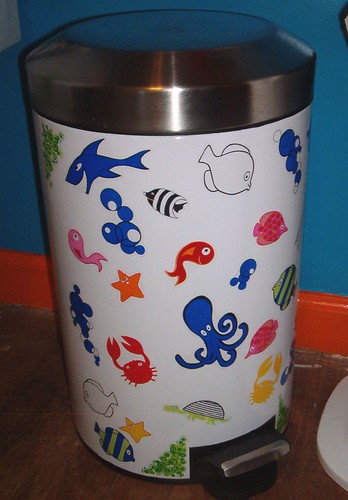 to save on space). Then you can just gather up the bag to haul with you to the laundromat — no touching of the diapers necessary! In most cases, the diaper pail liner can go right in the wash with your diapers — dump the diapers out first, of course, and consider getting a plain white liner bag so there'll be no potential running of color dyes in the hot cycle. Sprinkle a little baking soda into the bag or essential oil onto a cloth wipe and toss it in to absorb odor if it's bothering you. I found that leaving our pail open was better, because the diapers dried out and the odor dissipated quickly, and we had ours washed just once a week with the diaper service.
to save on space). Then you can just gather up the bag to haul with you to the laundromat — no touching of the diapers necessary! In most cases, the diaper pail liner can go right in the wash with your diapers — dump the diapers out first, of course, and consider getting a plain white liner bag so there'll be no potential running of color dyes in the hot cycle. Sprinkle a little baking soda into the bag or essential oil onto a cloth wipe and toss it in to absorb odor if it's bothering you. I found that leaving our pail open was better, because the diapers dried out and the odor dissipated quickly, and we had ours washed just once a week with the diaper service. - For the wet-pail method: Generally I recommend the dry-pail, for reasons including the fact that having a big wet tub of water is a drowning hazard for young children. If you use a wet pail, please make sure your pail latches securely with a childproof lock. The advantage of the wet-pail method for apartment dwellers is that diapers will get a presoak before you bring them to the laundromat, helpful for cutting down on staining if you're washing just once a week. Other downsides of the wet-pail method are that you'll have to change out the nasty water every other day or so somewhere to prevent mildew and odors, and that you'll be stuck lugging your super-heavy, soaked diapers to the laundromat or basement laundry room.
- Combination-pail method: Zany Zebra Designs offers a comparison of dry vs. wet pails plus a combination method that's somewhere in the middle: Soak, dunk, or spray poopy diapers, and then put them, still sopping, into the pail. This eliminates the drowning hazard, should cut down on staining, and makes dealing with pee diapers easy (no dunking or spraying necessary). The combination method sounds like a nice middle ground for apartment dwellers who are washing infrequently. The only danger I see is the potential for mildew, so be careful, particularly if you live in a humid climate.
- Get rid of solid poop before putting diapers in the pail by shaking it into the toilet. If you think other machine users will complain of poop going through the washers, you can also use disposable liners and/or a diaper sprayer (or dunk poopy diapers in the toilet or rinse in the sink — something like this Diaper Duck can make it less gross for you).
Staining and pre-treating:
- Bac-Out
by Biokleen is a good green stain remover to have on hand. Spray in advance any splotch that looks like it might set.
- See above about the benefits of the combination pail method.
- Try hanging your diapers on a sunny balcony or in a window to let the sun bleach out stains, if that's an option.
Now I'll just run through the pros and cons of using communal laundry rooms and laundromats, to help you figure out which sounds like a better option:
WASHING IN AN APARTMENT LAUNDRY ROOM
Pros:- If your building has a communal laundry room, then it's on site, and you don't have to pack up your baby (and/or other kids) to travel to a laundromat.
- Usually the prices are cheaper per load.
- You can often store your supplies in the laundry room, assuming there are lockers or shelves for residents' use, saving you from having to lug them with you. If the room doesn't have such storage but has room for it, suggest it to the managers. It's easy enough for them to set up a shelf and let residents each bring a bin into the room, and if the room locks, the only thievery issues will be from other residents mooching your detergent.
Cons:
- Other residents will be waiting to use the washers and dryers, which might affect when you can get your own loads done.
- Other residents might complain that you're washing poop in the washers. This is a rather silly objection, but you should be prepared to answer it. Washers get things clean; if they don't, then they're no good as washers. The wastewater flows out through the pipes and does not linger to get anyone else's clothes dirty. You could promise to wash a load of regular laundry following each diaper load, and you could pledge to use disposable liners or spraying/dunking so that solid poop is flushed away beforehand, if that makes people feel better.
- Other residents might use cleaners that are harsh on your diapers that do linger, like bleach. I read on one site, which of course I now cannot locate, a recommendation to run a load of regular laundry first or wipe out the washer with vinegar before loading your cloth diapers.
- Depending on where the laundry room is located, it might not be much more convenient to get to than a laundromat. We had a couple laundry rooms that required a trek outside and up and down several staircases, then through meandering basement corridors. In a case like that, a bright laundromat within easy distance might be more appealing.
WASHING IN A LAUNDROMAT
Pros:- Often the laundromat washers and dryers are larger, or there are some larger ones available, meaning fewer loads if you have enough diapers to fill a large-capacity machine.
- Proximity of coin machines!
- You will be inspired to get all your laundry done in one go, rather than doing a little here and there. (This could be either a pro or a con!)
- Laundromats usually have enough machines that no one's waiting for you specifically to finish.
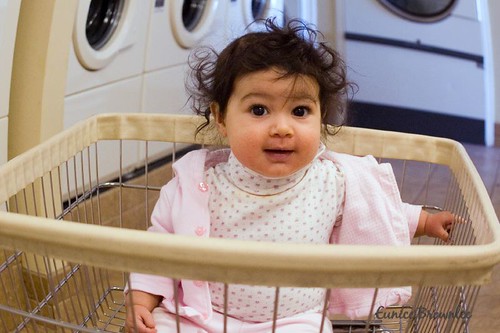
Cons:
- You have to schlep yourself, your supplies, your laundry, and potentially any young folk with you, and then keep said young'uns amused.
- The machines usually cost more, although look for specials at the locations near you. Around here, weekly specials are popular, such as a percentage off every Wednesday.
- As with the communal laundry room, be prepared to answer objections to washing diapers in a public machine.
- As with the communal laundry room, be aware of potentially harmful ingredients ending up on your diapers.
A look at non-standard washing machines
WASHING IN YOUR APARTMENT
I hated my apartments' laundry rooms. Hated with a passion. Both were creepy basement laundry rooms shared with the other renters. In both cases, the laundry room required going outdoors, into the (frequent) drizzle, up and down various staircases, and through heavy fire doors. Our latest one had a circuitous route with several challenging doors along the way, and all the lights were on timers, which meant they would shut off on you unpredictably, leaving you in the eerie depths of the dank basement.I couldn't stand it, so in our last place I researched other ideas for doing laundry. Besides doing some in the sink (which I did!), I found there are a few types of apartment-friendly washing machines out there.
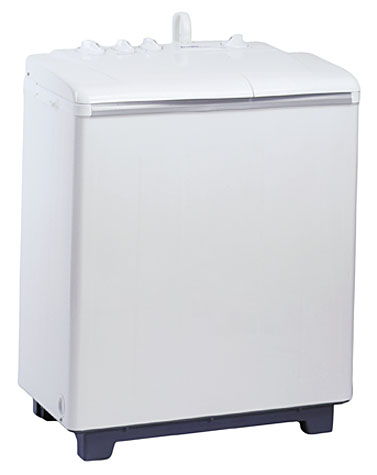
After much research and hemming and hawing, I ended up purchasing the Danby Twin Tub
washer with spin dryer for about $400 shipped. Before you let the terms "washer" and "dryer" fool you, let me describe it in a little more detail. It is a portable machine that stands about counter high and is on wheels. It has two tubs (hence, the twin-tub name!), one of which is a washing tub, and one of which is a centrifuge-like spinner. You plug the washer into a common outlet (no specialty voltage needed), route the waste hose into a nearby sink (no permanent installation necessary), and hook the water hose onto a normal faucet, such as from the kitchen sink. The spinner is not a "dryer," per se, in that it doesn't dry clothes, but it does wring all the excess water out of them, cutting line-drying time considerably. I've put a more thorough review over on Hobo Mama Reviews so I don't elongate this post any more than I already have. Just as a quick review, though, I'll say that I really appreciated it as an option for apartment dwelling, since there's no venting or special installation needed. I loved that I had complete control over the washing process and how clean our laundry got. But, it's a lot more work to wash and dry clothes (or diapers) in than a regular washer/dryer, as I have joyfully discovered since moving to a place with my own standard machines.
- I don't remember seeing much else in the way of other petite, portable washing machines when I was last in the market, but the Haier HLP23E Electronic Pulsator Top-Loading Portable Washing Machine looks like it might be a great contender: a little more automated but not pricey. It doesn't have the spinner, but you could add a portable dryer (see below).
The other main option I looked at was some sort of ventless combination washer/dryer
, which would also plug into a standard outlet and not require venting. It would be a single machine and much more powerful than the Danby. They're somewhat common in Europe and Asia, or so I hear, but not much in use in the States. The clothes are washed and dried in a single, very long cycle. But my sister-in-law had one in her condo and absolutely hated it, saying each load took way too long and came out still damp and wrinkled. The other negative for us was the much steeper price tag, generally around $1,000, particularly since they're less common here. We found one used on craigslist that we were eager to try out — and it never worked. It was so heavy I almost busted a gut moving it into our apartment, and then we had to move it back out and pay the junk people to come haul it away, so what a waste!


I've just heard of this Haier portable compact dryer
that I think looks adorable. It vents with a hose out a window, so there's no special duct installation needed. If you had the Danby with the very efficient spinner in combination with this dryer, you'd be golden.
Pros:
- You have total control over how you wash and dry your cloth diapers. Extra rinse, long soak, storing the diapers in the washer instead of a pail — it's all up to you!
- The machine we chose (the Danby) did a marvelous job of getting our laundry super clean with less wear and tear.
- You can save on money in the long run by doing your laundry in your own machines rather than with quarters in someone else's.
- You have all the convenience of doing laundry at home. You don't have to compete with other users of the machine or get to the laundromat during certain hours. You don't have to bring children with you to do laundry.
- Generally speaking, models like these are more energy efficient than standard models and use less water. If you skip the drying, you're being even greener.
Cons:
- There's an upfront cost for the machine(s).
- You shouldn't need permission from your landlord to install a portable washer or dryer, but he or she might still have issues with the situation, with fears of flooding and water damage, the heavy weight of the combo machines (the Danby is light, but the combos are really heavy), or excessive use of shared (hot) water sources.
- Washing loads in a non-standard washer takes a lot more effort and time, in my experience, than using a regular model. This was the biggest drawback for me.
More information on all these options over at Hobo Mama Reviews.
HAND WASHING
Not even joking, but this is an option! Maybe not your first choice, but here you go, for the ultimate in making do: "Handwashing Cloth Diapers" at Zany Zebra Designs has step-by-step instructions for washing diapers in the sink or tub. Even if this isn't your standard solution, this is useful if you're in a pinch and can't make it to the laundromat that day, or if you're on vacation and need to do half a load in your hotel room.Alternatives to washing cloth diapers in an apartment
USE A DIAPER LAUNDRY SERVICEI wrote before about how we hearted our diaper service.
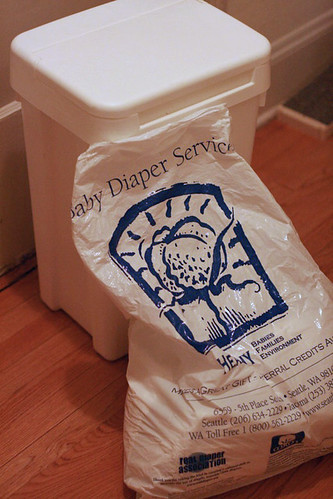 Even though I have my own washer and dryer now, I'm torn with whether we'll just go the diaper service route again. It was that marvelous.
Even though I have my own washer and dryer now, I'm torn with whether we'll just go the diaper service route again. It was that marvelous.Pros:
- Super convenient! You bundle up your bag of dirty diapers (no scraping, no soaking!) and put it outside each week. Like magic, it is replaced with a bag of fresh, clean prefolds for the coming week. Ah!
- The people who work there (at least at ours!) are helpful and knowledgable and can teach you how to do new folds or help you determine when to move up a size. Our driver was a champ, coming out even in blizzards!
Cons:
- Diaper services are rare, so they're not available in all areas. For pointed instance, there isn't one near Missy. The Real Diaper Industry Association has this finder up for the United States and Canada (or you could start your own — heh heh).
- Diaper services cost more than washing your own diapers. See my fabulous math skills put to the test above. But then remember that I majored in English.
- You don't get the fun of building a fancy stash! Though you can have fun with covers.
By the way, our diaper service in Seattle is holding a monthly Baby Diaper Service 101 class on cloth diapering, where you can have all your questions about the diaper service or using cloth diapers answered.
ELIMINATION COMMUNICATION
Another thing to look into is elimination communication, which for us greatly decreased the number of diapers we needed overall, particularly since it led to ending our diaper days with Mikko right around the 2-year mark — however, it greatly increased the amount of diapers we used as we were figuring out EC in the beginning.If you're willing to go full-on nakeybutt and let the puddles fall where they may, you can get by with fewer diapers. For those of you reading this, however, you're likely in a rental (with — horror! — wall-to-wall beige carpets), so going entirely diaper-free just might not be a good option. EC can help you get a handle on your diaper use, though, and potentially lead to earlier potty independence. If you do a combination of EC (even part-time is beneficial) and diapering, you might find you're using few enough cloth diapers to make the laundry more manageable.
GIVE UP
I'm not putting this in to be defeatist, just tolerant. Is it good to use cloth diapers? Yes, it's good for your baby, and it's good for the earth.But! If washing them is going to stress you out beyond belief, and other options are not available, then cut yourself some slack. Particularly in the vulnerable newborn period, where you might be just figuring out breastfeeding and caring for an infant, handling additional urgent loads of laundry in an inconvenient way might be just too much.
If you're committed to or at all interested in using cloth diapers, know that it is possible, and do the research to set up how you intend to manage. But then give yourself some grace, and don't see it as all-or-nothing. It might take awhile to get into your rhythm of cloth diaper usage, and that's ok, too. As with many other parenting-related issues, handling your cloth diaper laundry does get easier with time, and you can figure out a way for it to work for you.

Have you washed cloth diapers while living in an apartment or similar situation? Give us your best tips and tricks for how someone without a washer/dryer can manage.
Photos (excluding product photos) courtesy, from top,
Jake Krohn, me, tami abigador pearson, hope and megan, pinprick,
m.henry, Eunice Brownlee, me, and me, from flickr (cc)
Jake Krohn, me, tami abigador pearson, hope and megan, pinprick,
m.henry, Eunice Brownlee, me, and me, from flickr (cc)
Disclosure: Amazon links are affiliate links.
See my full disclosure policy here.
See my full disclosure policy here.










 I'm Lauren Wayne, writer and natural parent. I embrace attached parenting with an emphasis toward green living.
I'm Lauren Wayne, writer and natural parent. I embrace attached parenting with an emphasis toward green living. 


13 comments:
um...i'm not sure how long ago this was posted, but i think that you are AWESOME! i found this while researching portable washers for apartment dwelling and diaper washing for my pfc's (potential future children). so in depth and so personal...really great, informative, and helpful. also, i'm inspired more and more every time i hear someone else mention that they had a home birth. so thanks for that, too.
We used cloth diapers with my older one to cut down on costs. But with him it was east because we had a washer/dryer in the apartment.
We have since moved to an apartment where there is a laundry room down the hall. I have been amazed at how much harder laundry has become. I thought it was going to be about the same since the room is just down the hall. But if you need diapers washed NOW and the washer are full well you are just s.o.l. Plus we noticed the cost of washing and drying is actually more expensive than just buying the target brand diapers for my daughter. It makes me really sad to say our cloth diaper adventures are pretty much over. We have kept them in case we go visit parents or friends that have washer and dryers in their homes. But on a regular basis we use disposables.
We did 2 years of diapers at a laundromat and are now in an apartment with a shared washer. The apartment washer is actually more expensive than the laundromat was because we would go on the cheap day before. We just got a Wonder Wash and I now was a day's worth of diapers first thing in the morning. We use the combo wet/dry pail method as well. As far as I know, we can put the laundry on the railing, so I do that too.
I just assumed since we didn't have our own washer that it wasn't even an option! Now we do have our own washer so that's not a problem, but my cluelessness is. Slightly off-topic but do you know of a good link that explains cloth diapering on a really really basic level? Because I have no clue what "pre-folds" mean or what the covers are for & such-I need a glossary explaining what all the different parts needed are! Lol.
We live in an apartment, and I was determined to do cloth despite all the obstacles.
I'm still learning as we go, but I have a couple of things that work so far.
I rinse every single diaper that goes on her butt and comes off. Even if it's to rinse the poop off, it gets rinsed. I've found this helps with stains.
Dryer balls! Dryer balls help eliminate the drying time on my cloth diapers insanely. I just started using some, and the drying time has cut back by like at least 25 minutes, which for us means only one cycle in the dryer when we have to use it it.
I second getting a drying rack!
We've managed to get our diaper washing days down to twice a week, sometimes a third stuck in there if the diapers get super stinky. I generally put the diapers in the tub the night before, soaking them with a tiny bit of detergent, 'stirring' them a handful of times before I go to bed.
It is doable, and even with the cost of detergent, and diapers, we're still saving money. Plus a cloth bum is a cute bum.
Lauren, You are the Queen Bee of extremely thorough informative posts. I have never lived in an apt but I've had people ask me about how to manage cloth diapers while they lived in one and now I can lead them to your post! Hooray!
yay! thank you thank you!!! this was SO worth waiting for (as i knew it would be). i'm really excited to start cloth diapering.. i just need to complete my stash and have a baby.
i actually had a dream last night that i had the baby... a boy. i was worried because i haven't prewashed my diapers yet and i hadn't even ordered any detergent! eek!
i am a bit worried about different diapers having different care instructions - and as you could tell by my stash so far, it's pretty varied! i guess i'll just have to see how things go..
Thor offers a washer dryer combo as well. The company is introducing a new model for 2011 that will offer and internal water heater - great for washing cloth diapers.
This was so helpful! Thank you so much for taking the time to share all of this!
I didn't even READ this when you first posted it. I merely skimmed it because Sasha was 1yo and we were already happy with disposables. I am, however, considering cloth this time and dug up this post to read.
Thank you so much for confirming that disposable liners are still available! I used them 20 years ago, but hadn't seen any in the stores. And on a ROLL, no less... that was kind of cool. And biodegradable is, of course, wonderful!
Thanks for this article. Now... if I could find a community that gives away diaper covers... I have 8 months to find one. lol
@Momma Jorje: That would be so fun if you did cloth! I needed new covers for this baby since the moths attacked my last ones :( and I found lots on eBay and at the local consignment shop. There are also diaper swapping groups online. BUT, just let me know if you decide to go for it, and I can hook you up with our outgrown ones!! :)
Thank you so much for this great post! I'm going to share it with other parents who are thinking about cloth diapering, but don't have their own in-home laundry. It's also a great rundown for travelling too. At home we use pockets and fitteds, but when we're traveling, we switch to prefolds as they wash and dry so quick. Thanks!
Thank you, thank you! I'm in an apartment that has its own washer and dryer... but they're coin operated just like a laundromat. Crazy, right? It was awesome to see all this info laid out in one post - in fact I'm linking here in my next Montessori Moments post which is scheduled to come out on Saturday.
Post a Comment